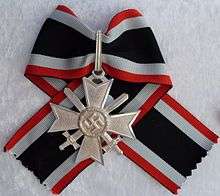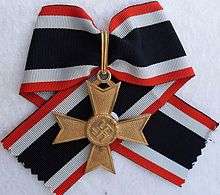War Merit Cross
| War Merit Cross | |
|---|---|
|
War Merit Cross (2nd class, without swords) | |
|
Awarded by | |
| Type | Military medal |
| Eligibility | German military personal and civilians |
| Awarded for | Meritorious service at the front or behind the lines |
| Status | Obsolete |
| Statistics | |
| Established | 1939 |
| Last awarded | 1945 |
| Precedence | |
| Next (higher) | Iron Cross |
| Related | War Merit Medal |
|
Ribbon | |
The War Merit Cross (German: Kriegsverdienstkreuz) was a decoration of Nazi Germany during the Second World War, which could be awarded to military personnel and civilians alike. By the end of the war it was issued in four degrees; and had a related civil decoration. It was reissued in 1957 by the Bundeswehr in a De-Nazified version for veterans.[1]
Grades, award criteria and design
This award was created by Adolf Hitler in October 1939 as a successor to the non-combatant Iron Cross which was used in earlier wars (similar medal but with a different ribbon). The award was graded the same as the Iron Cross: War Merit Cross Second Class, War Merit Cross First Class, and Knights Cross of the War Merit Cross.[2] The award had two variants: with swords given to soldiers for exceptional service "not in direct connection with combat", and without swords for meritorious service to civilians. Recipients had to have the lower grade of the award before getting the next level.[3]

The ribbon of the War Merit Cross was in red-white-black-white-red; that was, the red and black colors being reversed from the ribbon of the World War II version of the Iron Cross. The ribbon for the War Merit Medal was similar, but with a narrow red vertical red strip in the center of the black field.[4] Soldiers who earned the War Merit Cross 2nd Class with Swords wore a small crossed-swords device on the ribbon. The War Merit Cross 1st Class was a pin-backed medal worn on the pocket of the tunic (like the Iron Cross 1st Class). The ribbon of the War Merit Cross 2nd Class could be worn like the ribbon of the Iron Cross 2nd Class (through the second buttonhole).[3] Nonetheless combat soldiers tended to hold the War Merit Cross in low regard, referring to its wearers as being in 'Iron Cross Training'.[5] The Knights Cross of the War Merit Cross was a neck order and worn the same way as the Knights Cross of the Iron Cross.[6]
Award history
The Knights Cross of the War Merit Cross was considered to be ranked higher than the German Cross in silver, but below the Knights Cross of the Iron Cross.[6] A total of 118 awards of the Knights Cross of the War Merit Cross with swords, and 137 awards without swords were awarded.[6] Considering the relative rarity of the award compared with the grades of the Knights Cross of the Iron Cross, it took on "extra meaning" it did not necessarily deserve, as it ranked below the Knights Cross of the Iron Cross.[6] For example, Reichsmarschall Hermann Göring made a concerted effort to get Hitler to award him this order, much to Hitler's annoyance. In response, Hitler outlined a series of criteria governing the awarding of this decoration and the philosophy of such awards, and directed that "prominent party comrades" were not to be awarded with the Knights Cross of the War Merit Cross (or similar decorations), and withdrew the proposed awards of this order to Gauleiter Erich Koch and Herbert Backe. Directing his comments at Göring personally, Hitler ordered that such attempts to gain this award be stopped.[6]
Also, six persons received two Knights Cross' of the War Merit Cross (each one with and one without Swords): Walter Brugmann, Julius Dorpmüller, Karl-Otto Saur, Albin Sawatzki, Walter Schreiber, and Walter Rohlandt.

There was one extra grade of the War Merit Cross, which was created at the suggestion of Albert Speer: The Knights Cross of the War Merit Cross in Gold (German: Goldenes Ritterkreuz des Kriegsverdienstkreuzes), but this was never officially placed on the list of national awards as it came about in late 1944 and there was no time to officially promulgate the award before the war ended. The Knights Cross of the War Merit Cross in Gold (without swords) was awarded 'on paper' to two recipients on 20 April 1945: Franz Hahne and Karl-Otto Saur.[7]
The wearing of Nazi era decorations was banned in Germany after the war, as was any display of the swastika. Veterans awarded the War Merit Cross were therefore unable to wear it, either in uniform or - publicly - on civilian dress. In 1957 the Federal Republic of Germany authorised alternative 'de-nazified' replacement versions of World War II period war decorations. These could be worn both on Bundeswehr uniform and in civilian dress. The new version of the War Merit Cross replaced the swastika on the obverse central disc of the cross with the date "1939" (as on the reverse disc of the original version), the reverse disc being blank. The wearing of Nazi era decorations in any form continued to be banned in the German Democratic Republic until German reunification in 1990.
War Merit Medal
Closely related to the War Merit Cross was the War Merit Medal (German: Kriegsverdienstmedaille), designated on 19 August 1940 for civilians to recognize outstanding service in the war effort.[8] It was usually awarded to those workers in factories who significantly exceeded work quotas. The War Merit Medal was awarded to Germans and non-Germans, to men and women. An estimated 4.9 million medals were awarded by the end of the war in Europe.[8]
Notable recipients of the War Merit Cross
- Alfred Ingemar Berndt
- Karl Böhm
- Philipp Bouhler
- Wernher von Braun
- Walter Dornberger
- Walter Brugmann (2-time Knights Cross)
- Friedrich Buchardt
- Günther Burstyn
- Adolf Butenandt
- Kurt Daluege
- Julius Dorpmüller (2-time Knights Cross)
- Karlfried Graf Dürckheim
- Karl von Eberstein
- Adolf Eichmann
- Reinhard Gehlen
- Otto Günsche
- Eugen Hadamovsky
- Franz Hahne (Knights Cross in Gold)
- Karl Hanke
- Adolf Heusinger
- Reinhard Heydrich (posthumous)
- Franz Josef Huber
- Friedrich Jeckeln[9]
- William Joyce (1st & 2nd Class, without Swords)
- Hans Jüttner
- Ernst Kaltenbrunner
- Hasso von Manteuffel (2nd Class)
- Dr. Josef Mengele
- Wilhelm Mohnke
- Heinrich Müller
- Arthur Nebe
- Egon von Neindorff
- Franz Neuhausen
- Franz von Papen (Knights Cross)
- Oswald Pohl
- Ferdinand Porsche
- Walter Rohlandt (2-time Knights Cross)
- Karl-Otto Saur (2-time Knights Cross & Knights Cross in Gold)
- Albin Sawatzki (2-time Knights Cross)
- Walter Schellenberg
- Kurt Schmidt
- Karl Eberhard Schöngarth
- Walter Schreiber (2-time Knights Cross)
- Hermann Senkowsky
- Josef Spacil
- Albert Speer (Knights Cross)
- Otto Stapf (officer)
- Rudolf Toussaint
Notes
- ↑ Angolia 1987, pp. 300–305.
- ↑ Angolia 1987, pp. 300–305, 336.
- 1 2 Angolia 1987, p. 300.
- ↑ Angolia 1987, pp. 300, 301, 336, 337.
- ↑ Angolia 1987, p. 302.
- 1 2 3 4 5 Angolia 1987, p. 308.
- ↑ Angolia 1987, pp. 309, 310.
- 1 2 Angolia 1987, p. 306.
- ↑ Fleming, Alexander (1987). Hitler and the Final Solution. University of California Berkeley. pp. 99–100. ISBN 0-520-05103-3.
References
- Angolia, John (1987). For Führer and Fatherland: Military Awards of the Third Reich. R. James Bender Publishing. ISBN 0912138149.
Further reading
- Lumsden, Robin (2001). Medals and Decorations of Hitler's Germany. Airlife Publishing. ISBN 1-84037-178-1.
